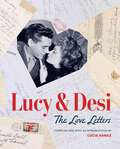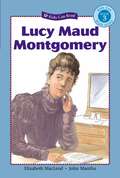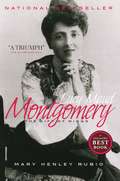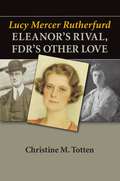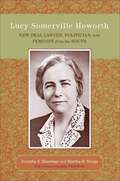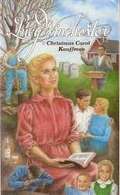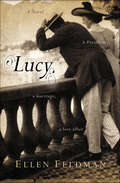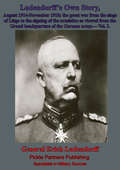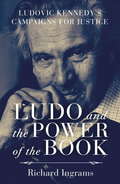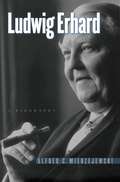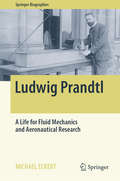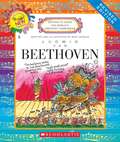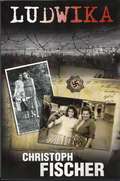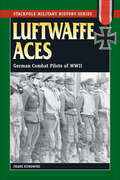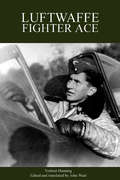- Table View
- List View
Lucy & Desi: The Love Letters
by Lucie ArnazA treasure trove of previously unseen love letters between Lucille Ball and Desi Arnaz, spanning their courtship through I Love Lucy fame and beyond, tells the couple&’s real-life love story in their own words, alongside rare photos from the family scrapbooks. After Lucille Ball&’s death in 1989, dozens of private letters between Lucy and Desi Arnaz were discovered. Now, for the first time, daughter Lucie Arnaz shares the complete collection in this remarkable volume that reveals the romance of one of the most famous couples in history more intimately than anything that has ever been written about them. At turns the letters disclose longing, ambition, jealousy, humor, and, above all, a passionate love affair that has claimed the world&’s interest for more than half a century. This extraordinary collection takes readers back to America during World War II, to the lives of a young couple in the early years of their relationship, with budding careers in Hollywood that were still far from their heyday as the nation&’s top stars. Each letter contains a bit of history as they talk about where they are, what they are doing, and what is going on in the world around them—whether it be a wardrobe fitting with a celebrated designer, remembering the last sensuous night they spent together, or trying to buy just the right refrigerator to please your mother-in-law during wartime rationing. Lucille Ball and Desi Arnaz weremarried from 1940 to 1960, and while the bulk of the letters were written in the early 1940s, the compendium reflects their entire relationship, from an early courtship, through long periods of separation due to work and world events, to a bittersweet end after nearly two decades. This stunning book takes readers as close as possible to the actual letters by featuring reproductions complete with envelopes, stamps, postmarks, and Lucy and Desi's own custom stationery. Further illustrated by rare photos from the Arnaz family scrapbooks, this volume is a revelatory look at a complicated and captivating love story that will amaze even longtime fans who think they have seen it all.
Lucy Maud Montgomery
by Elizabeth MacleodMeet Lucy Maud Montgomery -- world-famous author. The story of her dedication to her craft and the creation of Anne of Green Gables, her best-loved novel, is told in level-appropriate language.
Lucy Maud Montgomery: The Gift of Wings
by Mary Henley RubioMary Henley Rubio has spent over two decades researching Montgomery's life, and has put together a comprehensive and penetrating picture of this Canadian literary icon, all set in rich social context. Extensive interviews with people who knew Montgomery - her son, maids, friends, relatives, all now deceased - are only part of the material gathered in a journey to understand Montgomery that took Rubio to Poland and the highlands of Scotland. From Montgomery's apparently idyllic childhood in Prince Edward Island to her passion-filled adolescence and young adulthood, to her legal fights as world-famous author, to her shattering experiences with motherhood and as wife to a deeply troubled man, this fascinating, intimate narrative of her life will engage and delight.From the Hardcover edition.
Lucy Mercer Rutherfurd: Eleanor's Rival, FDR's Other Love
by Christine M. TottenWhat more could there be to know about FDR, given how exhaustively his life has been written about? As it happens, there is more and that focuses on Lucy Mercer Rutherfurd, the queen of her Washington social circle, later FDR's friend and love-and Eleanor's rival, as the title of Christine Totten's work points out. In Lucy Mercer Rutherfurd: Eleanor's Rival, FDR's Other Love, Totten presents a carefully structured case for a deep and lasting but chaste love between Lucy and FDR, against the prevailing view that they were clandestine lovers. Totten's research into the personal memories of the Rutherfurd family and the public holdings of the FDR Library establishes a new rich understanding of Lucy Mercer Rutherfurd--her early life, her education, and her role in the social and political scene in Washington. This work gives Lucy Mercer Rutherfurd her due, as a woman in her own right as well as FDR's valued soul mate and friend.
Lucy Somerville Howorth: New Deal Lawyer, Politician, and Feminist from the South (Southern Biography Series)
by Anne Firor Scott Dorothy S. Shawhan Martha H. SwainBorn, raised, and retired in Mississippi, Lucy Somerville Howorth (1895--1997) was a champion for the rights of women long before feminism emerged as a widely recognized movement. As told by Dorothy S. Shawhan and Martha H. Swain, hers is a remarkable life story-from a small-town upbringing to a career as an attorney, an activist, and the last of a generation of New Deal women in Washington, D.C. She held a presidential appointment under every chief executive from Franklin Roosevelt to John Kennedy.Howorth was a fervent believer in the power of organizations to bring about change, and she became known for her leadership qualities, acumen, and quick appraisal of social problems, particularly as they affected women. Shawhan and Swain point out that her winsome personality, small stature, and delightful sense of humor also aided her as a female aspiring in a man's world. In 1931 she was elected to the Mississippi House of Representatives and, after campaigning for Roosevelt, was rewarded by the new president with a federal appointment. She served in a number of subsequent roles, rising to become general counsel of the War Claims Commission, at that time the highest legal position in an executive commission ever filled by a woman.Howorth worked relentlessly for the advancement of women, especially through the American Association for University Women and the National Federation of Business and Professional Women. She lobbied for equality in the workplace, helping to effect significant advances in government and the professions. In 1944, at the request of Eleanor Roosevelt, Howorth delivered the keynote speech at the White House Conference on Women in Postwar Policy-Making, the most memorable of her many public addresses.This first-ever biography of Howorth bestows long-overdue recognition of her many notable achievements and illuminates the activism of women in the decades often considered to be the doldrums of the women's movement.
Lucy: A Novel
by Ellen FeldmanAn utterly absorbing novel about a famous political marriage and an epic infidelity. On the eve of World War I, Assistant Secretary of the Navy Franklin Delano Roosevelt, fiercely ambitious and still untouched by polio, falls in love with his wife's social secretary, Lucy Mercer. Eleanor stumbles on their letters and divorce is discussed, but honor and ambition win out. Franklin promises he will never see Lucy again. But Franklin and Lucy do meet again, and again they fall in love. As he prepares to run for an unprecedented third term and lead America into war, Franklin turns to Lucy for the warmth and unconditional approval Eleanor is unable to give. Ellen Feldman brings a novelist's insight to bear on the connection of these three compelling characters. Franklin and Lucy did finally meet, across the divide of his illness and political ascendancy, her marriage and widowhood. They fell in love again. As he prepared to run for an unprecedented third term and lead America into war, Franklin turned to Lucy for the warmth and unconditional approval Eleanor was unable to give. Drawing on recently discovered materials to re-create the voice of a woman who played a crucial but silent role in the Roosevelt presidency, Lucy is a remarkably sensitive exploration of the private lives behind a public marriage. Reading group guide included.
Ludendorff's Own Story, August 1914-November 1918 The Great War - Vol. I: from the siege of Liège to the signing of the armistice as viewed from the Grand headquarters of the German army (Ludendorff's Own Story #1)
by Anon Anon General Erich Friedrich Wilhelm LudendorffAs the German army moved swiftly into its start positions at the beginning of the First World War, efficiently and seamlessly forming up for the hammer blow that was to fall on France it must have been with some pride that General Ludendorff would look upon the first grand strategical plan that he had a hand in. A cool, calculating planner dedicated to ensuring that chance played as little a part in war as possible General Erich Ludendorff was the product of the prestigious German Kriegsakademie. His memoirs on the First World War are an excellently detailed account of the planning and execution of the ambitious German High command and their thirst for VictoryAlthough known primarily as staff officer his initial service, in the German army, during the war, was at the siege of Liège for which he was awarded the coveted Pour La Mérite by the Kaiser himself. He was rushed to the embattled Eastern Front as Chief of Staff to General von Hindenburg, and the two made an impressive team winning that battles of Tanneburg and the Masurian Lakes. Once again Ludendorff, this time was his chief Hindenburg, was drafted in as a replacement to ensure the fortunes of the German forces, this time on the Western front in 1916. He operated as the prime mover in the German empire from this point until the end of the war; masterminding the 1918 offensives as the last throw of the dice before capitulation.This first volume covers his early career until 1917 and is enriched with maps of the campaigns of the First World War.Author -- General Erich Friedrich Wilhelm Ludendorff, 1865-1937.Translator -- Anon.Text taken, whole and complete, from the edition published in New York and London, Harper & Brothers, 1919.Original Page Count - 477 pages
Ludendorff's Own Story, August 1914-November 1918 The Great War - Vol. II: from the siege of Liège to the signing of the armistice as viewed from the Grand headquarters of the German army (Ludendorff's Own Story #2)
by Anon Anon General Erich Friedrich Wilhelm LudendorffAs the German army moved swiftly into its start positions at the beginning of the First World War, efficiently and seamlessly forming up for the hammer blow that was to fall on France it must have been with some pride that General Ludendorff would look upon the first grand strategical plan that he had a hand in. A cool, calculating planner dedicated to ensuring that chance played as little a part in war as possible General Erich Ludendorff was the product of the prestigious German Kriegsakademie. His memoirs on the First World War are an excellently detailed account of the planning and execution of the ambitious German High command and their thirst for VictoryAlthough known primarily as staff officer his initial service, in the German army, during the war, was at the siege of Liège for which he was awarded the coveted Pour La Mérite by the Kaiser himself. He was rushed to the embattled Eastern Front as Chief of Staff to General von Hindenburg, and the two made an impressive team winning that battles of Tanneburg and the Masurian Lakes. Once again Ludendorff, this time was his chief Hindenburg, was drafted in as a replacement to ensure the fortunes of the German forces, this time on the Western front in 1916. He operated as the prime mover in the German empire from this point until the end of the war; masterminding the 1918 offensives as the last throw of the dice before capitulation.This second volume covers from 1917 until the end of the War and is enriched with maps of the campaigns of the First World War.Author -- General Ludendorff, Erich Friedrich Wilhelm, 1865-1937.Translator -- Anon.Text taken, whole and complete, from the edition published in New York and London, Harper & Brothers, 1919.Original Page Count - 473 pages
Ludo and the Power of the Book: Ludovic Kennedy's Campaigns for Justice
by Richard Ingrams'Stirring' Roger Lewis, Daily Mail, BOOK OF THE WEEK'A warm and worthy tribute' The Times'Elegantly written, thought-provoking' The Lady'A lucid and affectionate portrait of one of the great journalists of his day' ObserverSir Ludovic Kennedy was a British journalist, television personality, humanist and author. Following a brief naval career, Ludo devoted his life to what he referred to as his 'lifelong obsession with miscarriages of justice' and he fought this cause tirelessly, until he died in 2009. He is best known for re-examining cases such as the kidnapping of American toddler Charles Lindbergh, about which he wrote his most ambitious book on injustice, The Airman and the Carpenter. Ludo's writings and work on other cases such as the murder convictions of Timothy Evans and Derek Bentley were unique in that they often dispelled the breeding ground for conspiracy theories and regularly heralded dramatic changes of public opinion. Ludo is considered to be hugely influential in the abolition of the death penalty in the UK as well as other legal reforms, most notably the Police and Criminal Evidence Act (1984) which obligated police to tape-record the questioning of suspects. His life story is one that deserves to be remembered and celebrated.Richard Ingrams first met Ludovic Kennedy in 1963 and the pair quickly bonded over their shared goal of exposing the fallible nature of the British justice system. Ingrams interweaves this biography with detailed analysis of the cases to which Ludo dedicated his life, vividly recapturing the spirit of his friend and colleague.
Ludwig Erhard
by Alfred C. MierzejewskiIn the first English-language biography of one of the most important figures in postwar German history, Alfred C. Mierzejewski examines the life and service of Ludwig Erhard (1897-1977), West Germany's first minister of economics and second chancellor. Erhard liberalized the German economy in 1948 and is generally considered the father of West Germany's "economic miracle--the period of extraordinary growth in jobs and improvement in the standard of living in the 1950s that helped stabilize Germany's first successful democracy. While recent scholarship has dismissed Erhard's influence on Germany's economic recovery, Mierzejewski returns to little-cited German analyses and Erhard's own record and concludes that Allied currency reform and Erhard's liberalization of the economy were crucial triggers for Germany's unprecedented economic boom. Mierzejewski provides insight into Erhard's policies, his ideas, his character, and his relationships with Konrad Adenauer and Charles de Gaulle. By offering a fresh account of Erhard's career as a leader in postwar West Germany, Mierzejewski provides a deeper understanding of Germany's economy as well as its democracy.
Ludwig Prandtl: Ein Unverstellter Blick Auf Sein Leben
by Michael EckertThis is a comprehensive biography of Ludwig Prandtl (1875-1953), the father of modern aerodynamics. His name is associated most famously with the boundary layer concept, but also with several other topics in 20th century fluid mechanics, particularly turbulence (Prandtl's mixing length). Among his disciples are pioneers of modern fluid mechanics such as Heinrich Blasius, Theodore von Kármán and Walter Tollmien. Furthermore, Prandtl founded the Aerodynamische Versuchsanstalt (AVA) and the Kaiser-Wilhelm-Institut für Strömungsforschung in Göttingen, both of them seeds for the growth of fluid mechanics in Germany. <P><P> Yet Prandtl was also a representative of aeronautical research - from Imperial Germany via the Weimar Republic to the "Third Reich". Although not a party member, he assumed the role of a goodwill ambassador for Nazi Germany. This objective treatment of his career will be of interest to all scientists and historians wanting to learn more about Prandtl's influence and the early development of fluid- and aerodynamics.
Ludwig Van Beethoven (Getting To Know The World's Greatest Composers)
by Mike VeneziaPresents a biography of Ludwig Van Beethhoven
Ludwig Von Mises: The Man & His Economics (The\collected Works Of Israel M. Kirzner Ser.)
by Israel KirznerIsrael Kirzner, a former student of Ludwig von Mises, looks at the influences of the economic debates in Europe on von Mises' thought, traces his theories as they developed in his writings, and discusses both critical and supportive commentators on von Mises.
Ludwig Wittgenstein: Philosophy in the Age of Airplanes (Jewish Lives)
by Anthony GottliebThe first biography in more than three decades of the Austrian-born thinker Ludwig Wittgenstein, one of the most influential philosophers of the twentieth century According to the philosopher Ludwig Wittgenstein (1889–1951), philosophy is a “battle against the bewitchment of our intelligence by means of language.” This audacious idea changed the way many of its practitioners saw their subject. In the first biography of Wittgenstein in more than three decades, Anthony Gottlieb evaluates this revolutionary idea, explaining the evolution of Wittgenstein’s thought and his place in the history of philosophy. Wittgenstein was born into an immensely rich Viennese family but yearned to live a simple life, and he gave away his inheritance. After studying with Bertrand Russell in Cambridge, he wrote his famous Tractatus Logico-Philosophicus while serving in World War I. He then took several positions as a primary-school teacher in rural Austria before returning as a fellow to Cambridge, where a cultlike following developed around him. Wittgenstein worked not only as a philosopher and schoolteacher, but also as an aeronautical engineer in Manchester and as an architect in Vienna. Gottlieb’s meticulously researched book traces the itinerant and troubled life of Wittgenstein, the development of his influential ideas, and the Viennese intellectual milieu and family background that shaped him.
Ludwig van Beethoven: Great Composer
by Anna Carew-MillerA German composer born in the 1700s, Ludwig van Beethoven has given the world some of the most well-known and long-lasting music of all time. From his Für Elise to his 9th Symphony (in which a choir sings words from the poem "Ode to Joy"), Beethoven's music is still loved, almost 200 years after his death. Amazingly, Beethoven composed music while being unable to hear almost anything from the time he was 26, a feat which makes his brilliant compositions all the more wonderful. Few musicians have had the incredible impact on music that Beethoven had. Learn the story of one of the most important musical composers of all time in Ludwig van Beethoven: Great Composer.
Ludwika
by Christoph FischerÈ la seconda guerra mondiale e Ludwika Gierz, una giovane donna polacca, è costretta a lasciare la sua famiglia e ad andare nella Germania nazista per lavorare per un ufficiale delle SS. Lì, si trova sul filo di un rasoio, costretta ad imparare a vivere come una cittadina di seconda classe in un mondo in cui una parola sbagliata potrebbe causare danni e ogni giorno potrebbe essere l'ultimo. Basato su eventi reali, questa è una storia di speranza in mezzo alla disperazione, di amore in mezzo alla perdita. . . alla fine, è la storia della sopravvivenza di una donna.
Ludwika
by Christoph Fischer Cibelle RavagliaDurante a Segunda Guerra Mundial, Ludwika Gierz, uma jovem polonesa, é forçada a deixar sua família e ir para a Alemanha nazista, onde trabalhará para um oficial da SS. Lá, Ludwika tem que aprender a conviver todos os dias com os perigos e riscos do regime nazista, sendo considerada inferior em um mundo onde uma palavra errada pode colocar sua própria vida em risco e onde todos os dias podem ser os últimos. Baseada em fatos reais, esta é um história de esperança em um mundo deseperador, uma história de amor em meio a perdas incalculáveis... enfim, é a história de uma polonesa que luta para sobreviver.
Ludwika: "Am Ende wird immer alles gut."
by Christoph FischerEs ist der Zweite Weltkrieg und Ludwika Gierz, eine junge Polin, die ihre Familie verlassen muss um in Nazideutschland für einen SS-Offizier zu arbeiten. Dort muss sie eine Gratwanderung durchmachen und erlernen, als Bürgerin zweiter Klasse in einer Welt zu leben, in der auch nur ein falsches Wort eine Katastrophe bedeuten und jeder Tag ihr letzter sein könnte. Basierend auf einer wahren Begebenheit ist dies eine Geschichte von Hoffnung, inmitten von Verzweiflung und Liebe inmitten von Verlust. . . Letztendlich ist es die Überlebensgeschichte einer Frau. Redaktionelle Rezension: "Dies ist die beste Art von Fiktion, da sie auf dem wirklichen Leben basiert. Ludwikas Geschichte zeigt das Ausmaß des menschlichen Leidens, das durch den Zweiten Weltkrieg verursacht wurde und mehrere Generationen und viele Nationen noch heute betrifft. Der Zweite Weltkrieg ließ niemanden unberührt, und Ludwikas Leben verdeutlicht diese tragische Tatsache. Sie erinnert uns aber auch daran, wie hell der menschliche Geist leuchten kann, wenn die Dunkelheit so unerbittlich fällt wie in Kriegszeiten. Dieses Buch ist eine Achterbahnfahrt voller Aktionen und Emotionen, die von Herrn Fischer gekonnt erzählt werden. Er brachte etwas Frisches und Neues zu einem Thema, über das bereits tausende von Geschichten erzählt wurden.
Ludwika: La lucha de una mujer polaca para sobrevivir en la Alemania nazi
by Christoph FischerEs la Segunda Guerra Mundial y Ludwika Gierz, una joven polaca, se ve forzada a abandonar su familia e ir a la Alemania nazi a trabajar para un oficial de las SS. Allí, su vida pende siempre de un hilo, y aprende a vivir como una ciudadana de segunda clase en un mundo en el que una palabra equivocada puede llevar al desastre, y donde cada día puede ser el último. Basada en hechos reales, es una historia de esperanza en medio de la desesperación; de amor en medio de las pérdidas...en fin, es la historia de supervivencia de una mujer. Comentarios editoriales: "Este es el mejor tipo de ficción: una historia basada en la vida real. La historia de Ludwika resalta la magnitud del sufrimiento humano causado por la Segunda Guerra Mundial, dolor que atravesó muchas generaciones y naciones. La Segunda Guerra no perdonó a nadie; todos salieron heridos, y la vida de Ludwika ilustra este hecho trágico; pero también nos recuerda cuánto puede brillar el espíritu humano cuando cae la oscuridad durante una guerra. Este libro es como un viaje en una montaña rusa, lleno de emoción y acción, narrado con mucha habilidad por el Sr. Fischer, autor que consiguió aportar algo nuevo y fresco al relatar un tema que ha sido narrado tantas veces".
Luftwaffe Aces in the Battle of Britain
by Chris Goss“An extraordinary analysis of the ‘scores’ chalked up by individual fighter pilots serving in the Luftwaffe during the Battle of Britain. So much detail!” —Books MonthlyThe term “fighter ace” grew in prominence with the introduction and development of aerial combat in the First World War. The actual number of aerial victories required to officially qualify as an “ace” has varied but is usually considered to be five or more.For the Luftwaffe, a number of its fighter pilots, many of whom had fought with the Legion Condor in Spain, had already gained their Experte, or ace, status in the Battle of France. However, many more would achieve that status in the hectic dogfights over southern England and the Channel during the Battle of Britain in the summer of 1940. A number would also be either killed or captured. Some of these men, individuals such as Adolf Galland, Werner Mölders, and Helmut Wick, who between them had claimed 147 aerial victories by October 31st1940, are well-known, but most are less so.In this book, the story of each of the Luftwaffe’s 204 Messerschmitt Bf 109 “aces” from the summer of 1940 is examined, with all of the individual biographies, detailing individual fates during the war, being highly illustrated throughout. Original German records from the summer of 1940, have been examined, providing a definitive list of each pilot’s individual claims. It also covers, to a lesser extent, those forgotten fifty-three Messerschmitt Bf 110 pilots who also achieved ace status by day and also by night between 10 July and 31 October 1940.“A fascinating book indeed.” —UK Historian
Luftwaffe Aces in the Battle of Britain
by Chris Goss“An extraordinary analysis of the ‘scores’ chalked up by individual fighter pilots serving in the Luftwaffe during the Battle of Britain. So much detail!” —Books MonthlyThe term “fighter ace” grew in prominence with the introduction and development of aerial combat in the First World War. The actual number of aerial victories required to officially qualify as an “ace” has varied but is usually considered to be five or more.For the Luftwaffe, a number of its fighter pilots, many of whom had fought with the Legion Condor in Spain, had already gained their Experte, or ace, status in the Battle of France. However, many more would achieve that status in the hectic dogfights over southern England and the Channel during the Battle of Britain in the summer of 1940. A number would also be either killed or captured. Some of these men, individuals such as Adolf Galland, Werner Mölders, and Helmut Wick, who between them had claimed 147 aerial victories by October 31st1940, are well-known, but most are less so.In this book, the story of each of the Luftwaffe’s 204 Messerschmitt Bf 109 “aces” from the summer of 1940 is examined, with all of the individual biographies, detailing individual fates during the war, being highly illustrated throughout. Original German records from the summer of 1940, have been examined, providing a definitive list of each pilot’s individual claims. It also covers, to a lesser extent, those forgotten fifty-three Messerschmitt Bf 110 pilots who also achieved ace status by day and also by night between 10 July and 31 October 1940.“A fascinating book indeed.” —UK Historian
Luftwaffe Aces: German Combat Pilots of WWII (Stackpole Military History Series)
by Franz KurowskiCombat biographies of seven ace pilots flying for the Nazi German air force during World War II, featuring in-the-cockpit accounts of aerial dogfights. Whether providing support for the blitzkrieg in Poland and France, bombing British cities and industrial centers, or attacking Allied fighters and bombers in the light of day and dark of night, the Luftwaffe revolutionized aerial warfare and experienced some of World War II&’s most harrowing combat. For the pilots who carried out these missions, every flight meant possible death and certain danger. Franz Kurowski puts readers in the cockpit with seven of these men—three day-fighter, on night-fighter, one close-support, and two bomber pilots—who were among the most successful ever to take to the skies.
Luftwaffe Fighter Ace: From The Eastern Front To The Defense Of The Homeland (Stackpole Military History Ser.)
by Norbert HannigA World War II memoir by the renowned German fighter pilot—from his Hitler Youth glider training to combat missions against the Soviet Air Force. Herr Norbert Hanning&’s wartime career makes for fascinating and highly informative reading on an aspect of the 1939-45 air war not often covered in the English language; primarily that of the campaign against the Soviet Union. He was one of the midwar-generation Luftwaffe fighter pilots and began operations with JG 54 on the eastern (Leningrad) front in early 1943; initially flying Messerschmitt Bf 109s before transitioning to the Focke-Wulf Fw 190. He became a Staffel CO and was credited with 42 victories, also serving with JV 44 (whose CO was Adolf Galland); he then returned to Germany towards the closing stages of the war to convert to Me 262 jet fighters. Many and varied were his experiences in action against the rejuvenated Soviet Air Force in the east, and the powerful western Allies over the homeland during the final chaotic months of hostilities, which culminated in his captivity. John Weal&’s skillful translation ensures that the fluid and descriptive style of the author is preserved. Thankfully, also, Norbert was a keen photographer who shot a profusion of images, all previously unpublished, many of which appear in this important book.
Luftwaffe Fighter Pilot: Defending the Reich Against the RAF and the USAAF
by Wolfgang FischerA Nazi Germany fighter pilot gives readers a bird's-eye view from the cockpit of aerial combat against the Allied forces in World War II. Within weeks of war being declared, Wolfgang Fischer had volunteered to join the Luftwaffe and spent nearly five of the succeeding six years of hostilities in uniform. During this time he was given a succession of postings varying from a long-range recce unit; as a decoder in a met office in occupied France; to a bomber squadron; and as a flying instructor, before joining a squadron of the famous Richthofen Geschwader in Italy, from where he was shot down in his FW 190 by Mustangs en route to Normandy. By now a Lieutenant, he survived to fly offensive rocket attacks over Gold Beach on D-Day, only to be shot down again on D+1, and captured and sent first to a hospital in the UK, then into captivity in the USA. He was finally repatriated in April 1946. His description of all these events is entertaining and well-written, ranging from comic to tragic. It is unique in flavor, giving a valuable insight into the undeniably typical lot of those serving in the air arm of the Third Reich. Expertly translated and edited by John Weal, this is a worthy accompaniment to Norbert Hannig's Luftwaffe Fighter Ace published by Grub Street in 2004.
